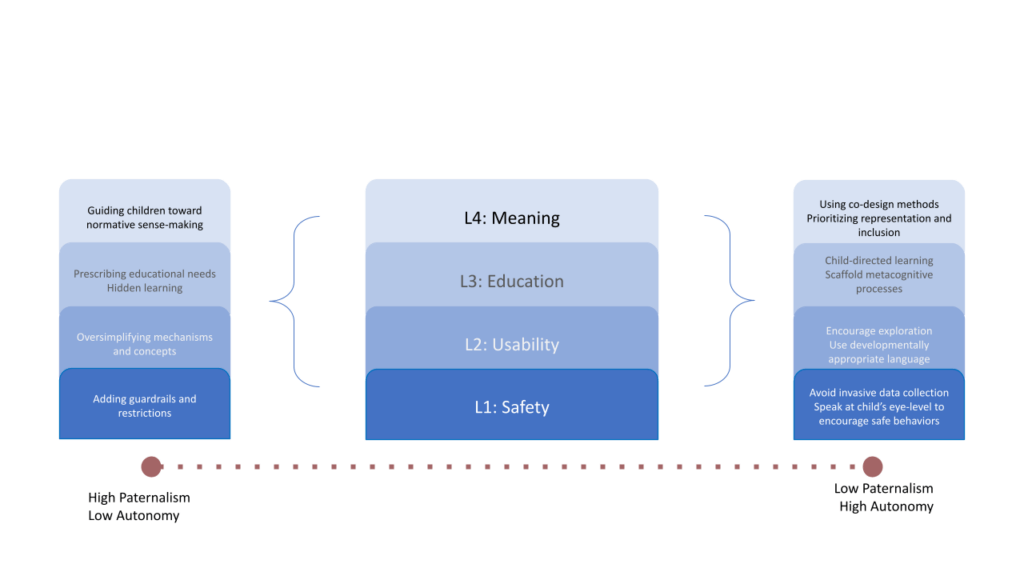What practical issues arise when involving children in designing digital products and services, and what can be learned from practitioners’ experiences? Given the Digital Futures Commission’s commitment to Child Rights by Design, we are glad to repost this blog from one of our Commissioner organisations, the Joan Ganz Cooney Center.
by Rotem Landesman, Jenny Radesky, and Alexis Hiniker
Along with rolling heat waves, rising gas prices, and the occasional new social media site, the recent news cycle has been dominated by commentary on the potential risks, harms, and benefits children may encounter when interacting with technology. States have made bold attempts to ban social media sites, parents are wondering how to talk to children about A.I. chatbots , and platforms are adding risk-reduction tools. However, it is rarely discussed how to increase children’s well-being in the digital ecosystem that now surrounds their daily activities.
Pundits advance arguments about both the benefits and risks that interacting with technologies might have for children, and research shows these different outcomes are not arbitrary. The way an experience is designed is one of the main determinants of whether children have positive or negative experiences when interacting with digital media. Rights-based frameworks for child-centered design have been proposed, but it is not understood how child well-being is integrated into the digital design process in real-world settings. In order to promote industry standards that support children’s positive media interactions, we first need to describe: what does designing for childrens’ digital well-being entail according to industry leaders in child-centered design?
Our research team presented our work exploring these questions at the Interaction Design for Children (IDC) conference in Chicago. We decided to investigate how practitioners conceive of and design for digital child well-being by talking to members of the industry who work for and with children.
We interviewed content creators, platform designers, user researchers, and founders who work with children about their perceptions of child well-being, how well-being is defined in their company, how they measure it, and how it influences content and feature decisions. These conversations gave us insight into on-the-ground perspectives of these professionals and possible next steps to push the child-centered industry towards a cohesive vision of designing for child well-being.
We saw that practitioners thought of well-being along four levels of increasing scope and breadth of commitment to designing for child well-being:
- Level 1: In the most narrowly scoped view of child well-being, interviewees focused on experiences that were safe for children. To them, this meant protecting children from online predators, unwelcome ads, and invasive data collection; these practitioners defined well-being as online safety.
- Level 2: The second level expanded in scope to include usability. Practitioners talked about fostering well-being in digital spaces by both ensuring the child’s safety and their ability to navigate and understand the interface.
- Level 3: These conceptualizations further expanded the scope of children’s digital well-being to include: creating safe experiences, creating experiences with developmentally sensitive usability, and creating experiences where the child will learn something through the interaction or content.
- Level 4: And then finally, practitioners who conceptualized well-being at the fourth and broadest level sought to design for safety, usability, learning, and contributing to the meaning of a child’s life. So, while they strived to create experiences for children which encompassed each of the three previous levels they further emphasized designing for empowerment, self-awareness, representation, interpersonal development, and more through the media they were creating.
One of our participants put this beautifully when they explained the fourth level as:
“…[a] whole-child sort of perspective where the child is not just getting their basic needs met, but they’re also being intellectually stimulated, they feel emotionally safe, they have supportive caregivers, they have close relationships with the adults around. . . it’s feeling free to play and wander and be curious and having stable relationships around you.”
In addition to these four hierarchical ways we saw practitioners think about digital child well-being, we also noticed that practitioners had different conceptualizations of children and their given autonomy, which influenced how they decided to design for well-being.

In some instances, designers sought to support children’s well-being by crafting an environment that would direct the child, leading them to specific curated experiences. In other instances, designers sought to support children’s well-being by crafting an environment that the child could direct and giving them the space to choose what to do, learn, and experience.
For example, one participant described an industry trend of assuming a lack of capability, which they found disrespectful and at odds with the goal of supporting child well-being. They recounted other designers saying things like, “Oh, kids won’t understand these words. These are too complicated of topics, but I completely disagree.” They went on to explain that even though children might not be able to pick out all the messaging presented to them, they most often understand the larger ideas and appreciate the topic.
These grassroots insights and ideas from practitioners, we believe, give us a unique perspective on the approaches of people who create products for children, compete in the marketplace, and navigate regulations and best practices. With this knowledge, we believe we can begin to move towards a grounded understanding of digital child well-being and how to design for it.
So what’s next? We see an opportunity for industry practitioners and academic researchers to drive towards consensus around detecting and evaluating when a child has benefited from a digital product, as we saw a discrepancy between the incredible commitment companies make to support digital child well-being and the metrics they use to measure the success of their efforts. Even designers making a level-four commitment to their users said they measure the success of their designs with simplistic measures like seeing “how many kids are playing and for how long,” “minutes per video, minutes per user,” “where we rank,” and “monthly active users.”
In some instances, participants positioned their success metrics as being in tension with their well-being goals rather than in service of them. Many practitioners expressed wanting to ask deeper questions to evaluate well-being effects with more sophistication, but those are not yet widely accepted in the industry.
To truly create beneficial digital experiences for children, whether through apps, games, TV, or otherwise, we need to know how to know them when we see them. If “we can’t make what we can’t measure,” as the adage goes, perhaps the next step should be that bridge between our products and their impact.
Rotem is a PhD student in the Information School at the University of Washington, co-advised by Dr. Katie Davis and Dr. Amy J Ko. Her research looks at developing metrics for wellbeing design in digital spaces, alongside fostering youth’s technological wisdom.
